The great Willie Nelson and his famous, well worn Martin guitar
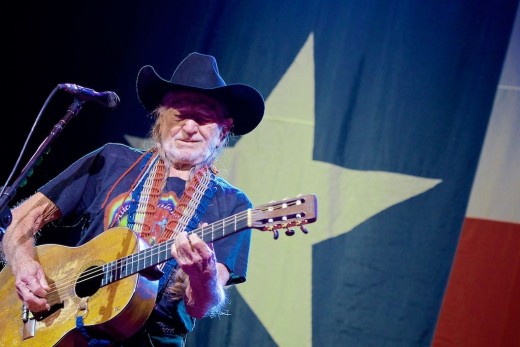
Source
Willie Hugh Nelson is
an American icon who needs no introduction. We'll introduce him here
just the same. Here in Texas where I've nearly always lived, Willie
doesn't even need his surname used. If you start talking about 'Willie,'
everyone will know who you are talking about.
The man is a real artist, and like are true artists, he is a nonconformist, and a rebel by nature. He says what he means, and does whatever he thinks is best, laws be damned. The world needs a lot more persons like Willie Hugh Nelson; and a lot less of the types who say what they think everyone wants to hear, and forever dances to the government's official drummer.
I grew up with Willie Nelson. He was a family member by proxy, if you will. You see, my mother's folks are often folks who play guitar and sing. Very often they play guitar and sing Willie Nelson songs. I started joining in with all of that at eleven or twelve years of age. I hung out with my grandfather a lot, and the grandfather was forever buying, selling, repairing, and trading in guitars and stringed instruments. He also liked to play guitar and sing, and often he sang the songs of Willie Nelson. I'll never forget hearing the guy play and sing Blue Eyes Crying In The Rain. It's a slow tempo tune, the chord changes are fairly easy (unless you're only then learning to fret and change chords while trying to strum in time) - grandpa had the voice for it too.
The man is a real artist, and like are true artists, he is a nonconformist, and a rebel by nature. He says what he means, and does whatever he thinks is best, laws be damned. The world needs a lot more persons like Willie Hugh Nelson; and a lot less of the types who say what they think everyone wants to hear, and forever dances to the government's official drummer.
I grew up with Willie Nelson. He was a family member by proxy, if you will. You see, my mother's folks are often folks who play guitar and sing. Very often they play guitar and sing Willie Nelson songs. I started joining in with all of that at eleven or twelve years of age. I hung out with my grandfather a lot, and the grandfather was forever buying, selling, repairing, and trading in guitars and stringed instruments. He also liked to play guitar and sing, and often he sang the songs of Willie Nelson. I'll never forget hearing the guy play and sing Blue Eyes Crying In The Rain. It's a slow tempo tune, the chord changes are fairly easy (unless you're only then learning to fret and change chords while trying to strum in time) - grandpa had the voice for it too.
A younger Willie Nelson with his Martin 'Trigger'
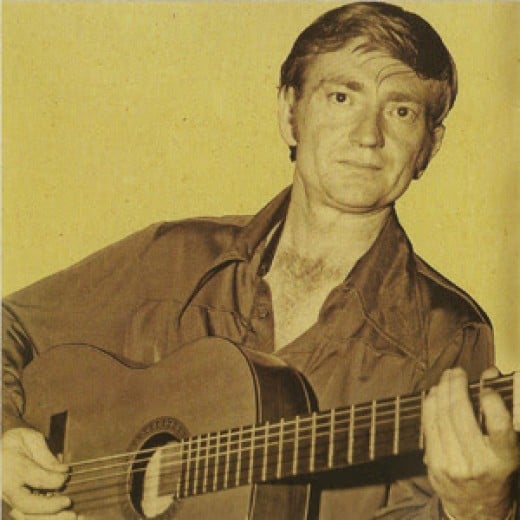
Source
Besides learning to
strum along to Willie Nelson songs, I spent a lot of time listening to
my grandfather tell me everything you could possibly want to know about
guitars, mandolins, banjos, and the business of building such things. I
learned what was good, why it was good, and what wasn't, and why it
wasn't. I learned that Martin guitars were among the finest creations
for making music on Earth, and I learned that Gibson guitars were also
something to be admired, played, and treated with the utmost respect.
I learned the amazing truth about how Willie Nelson wore a hole in his guitar for playing it so vigorously and so often. I also learned how completely unorthodox Willie's style of playing the guitar was, and why. Besides playing the guitar exactly 'wrong' by conventional wisdom, I also learned his instrument of choice was also 'wrong' for the music he played and still plays. Willie Nelson is a nonconformist, a guy who cares very little for anything remotely resembling a rule.
I learned the amazing truth about how Willie Nelson wore a hole in his guitar for playing it so vigorously and so often. I also learned how completely unorthodox Willie's style of playing the guitar was, and why. Besides playing the guitar exactly 'wrong' by conventional wisdom, I also learned his instrument of choice was also 'wrong' for the music he played and still plays. Willie Nelson is a nonconformist, a guy who cares very little for anything remotely resembling a rule.
Trigger - the wear and tear
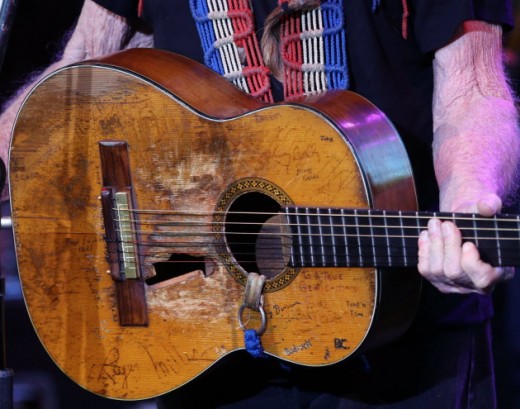
Source
Willie Nelson's guitar style
What is this nonsense I said about Willie Nelson playing the guitar all wrong?
Listen, I'm a nobody, just a scribbler on the web who can play the
guitar a little. All I'm saying here is Willie's entire style of play is
extremely unorthodox, and that you will never in your time on Earth
find a guitar instructor who'd teach another person to use the technique
Willie Nelson uses to play a guitar. Yes, Willie Nelson plays
beautifully. Wille Nelson's technique is his own, and he's very proud of
his guitar playing, as he should be. He's instantly recognizable as a
singer and a guitarist, and that sort of thing is very very rare.
Willie Nelson uses downstrokes almost exclusively in his soloing. This technique is his own, and will never be taught to anyone by an instructor because it prevents the player from ever being able to play very fast. Playing fast is over rated though, and Willie Nelson never needed to do it to sound great.
Now you may think of Willie Nelson as a country and western singer and guitarist, but the truth is different. Willie Nelson is secretly a jazz guitarist, he got interested in jazz from the music of Django Reinhardt. Willie is also a guy who infuses a lot of Latin musical styling into his music. The way to be memorable in music is to sound like yourself and no one else.
Another strange thing Willie Nelson does involves his guitar, 'trigger.' We're talking about a guitar so famous it has its own Wikipedia page. The thing about it is the particular guitar is a classical guitar, and classical guitars are built for nylon strings. Classical guitars like 'trigger' are meant to be played fingerstyle, but Willie is playing 'trigger' with a plectrum or pick. Now, to be sure, loads of people also do this, but they are not doing it on a classical guitar so much, and when they do it, they typically do that for a song or so - while Willie plays a classical guitar with a pick using almost all downstrokes in every single song of his you will ever hear. The guitar 'trigger' is also an amplified classical guitar. You may find another classical guitar with a pickup installed inside it somewhere in the world, but such things are far removed from normalcy with classical guitars.
Willie Nelson uses downstrokes almost exclusively in his soloing. This technique is his own, and will never be taught to anyone by an instructor because it prevents the player from ever being able to play very fast. Playing fast is over rated though, and Willie Nelson never needed to do it to sound great.
Now you may think of Willie Nelson as a country and western singer and guitarist, but the truth is different. Willie Nelson is secretly a jazz guitarist, he got interested in jazz from the music of Django Reinhardt. Willie is also a guy who infuses a lot of Latin musical styling into his music. The way to be memorable in music is to sound like yourself and no one else.
Another strange thing Willie Nelson does involves his guitar, 'trigger.' We're talking about a guitar so famous it has its own Wikipedia page. The thing about it is the particular guitar is a classical guitar, and classical guitars are built for nylon strings. Classical guitars like 'trigger' are meant to be played fingerstyle, but Willie is playing 'trigger' with a plectrum or pick. Now, to be sure, loads of people also do this, but they are not doing it on a classical guitar so much, and when they do it, they typically do that for a song or so - while Willie plays a classical guitar with a pick using almost all downstrokes in every single song of his you will ever hear. The guitar 'trigger' is also an amplified classical guitar. You may find another classical guitar with a pickup installed inside it somewhere in the world, but such things are far removed from normalcy with classical guitars.
Willie Nelson and his 'death row' guitar
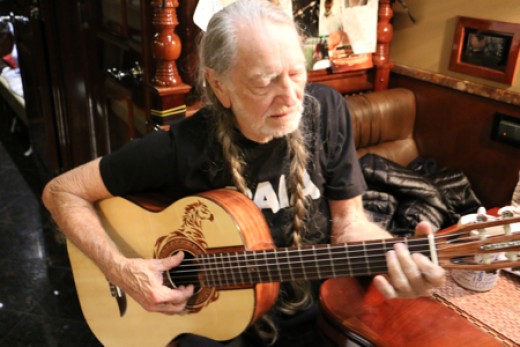
One of the few photos of Willie Nelson you will ever see with him playing a guitar other than trigger. | Source
The image above is one
of the only images of Willie Nelson with a guitar in hand that isn't the
famous 'trigger.' That particular guitar was made for him by a death
row inmate. The story of how Willie acquired his nylon string Martin is
one well documented elsewhere on the web, but suffice it to say it
involved the unfortunate death of the guitar he had been playing, and so
he was in a hurry to get a replacement, and wound up with the nylon
string Martin he has more or less been married to ever since.
Insofar as how and why Willie Nelson fell in love with trigger, it would be pretty shallow for me to describe that here when you can hear it from Willie himself. The following video is just that, Willie Nelson telling the tale of how he and his nylon string guitar, 'trigger,' became inseparable.
Insofar as how and why Willie Nelson fell in love with trigger, it would be pretty shallow for me to describe that here when you can hear it from Willie himself. The following video is just that, Willie Nelson telling the tale of how he and his nylon string guitar, 'trigger,' became inseparable.
Willie Nelson was born
in Abbott, Texas in 1933. Being born and living through the great
depression surely made an impact on Willie. The great depression made a
lasting and life long impact on everyone I've ever known who'd been
through that. He's a poet, a writer, a singer, song writer, actor, and
activist. Sometimes Willie will say that what he is truly proud of is
his guitar playing.
A founding member of the Texas 'outlaw country' music movement - Willie's appeal has never died out, and won't either. He's forever evolved his music, involved loads of younger musical stars in it, and he's always kept writing songs, touring, recording, and speaking out about the things he believes in. He has sold over forty million albums, and on almost all of them he was playing trigger, his Martin N-20 nylon string classical gutiar.
A founding member of the Texas 'outlaw country' music movement - Willie's appeal has never died out, and won't either. He's forever evolved his music, involved loads of younger musical stars in it, and he's always kept writing songs, touring, recording, and speaking out about the things he believes in. He has sold over forty million albums, and on almost all of them he was playing trigger, his Martin N-20 nylon string classical gutiar.
A 1969 Martin N-20, a guitar like 'trigger,' with a little less wear
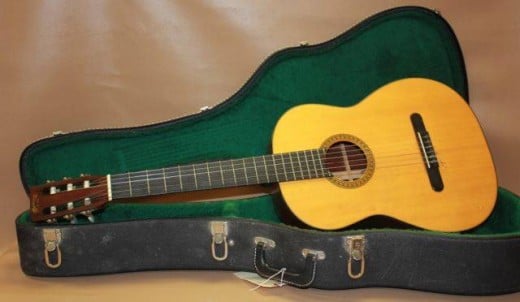
Source
The Martin N-20.
C.F.
Martin & Company started manufacturing Martin N-20 guitars in 1968.
The one Willie Nelson made famous is a 1969 model. The 68' and 69'
model Martin N-20s are of a shorter scale than classical guitarists
appreciated, so in 1970 Martin started making the same instrument with a
longer scale.
These guitars were never hot sellers. In 1969 Martin only produced 262 of these guitars. Were it not for Willie Nelson, these guitars would be very obscure guitars indeed. In 1969 these instruments were still produced with Brazilian rosewood for the back and sides, and that is a treasured tonewood now, as it is no longer easy to come by, and is pretty prohibitive for most insofar as costs go. Any newer model Martin N-20 you find will be of East Indian rosewood, and you'll lose very little, if anything at all, with that also fine tonewood. Of course should you be planning to play such a guitar with a pick, you should consider putting a pick guard on it. What follows is a more detailed list of the instruments specifications:
Construction: Standard, mahogany blocks/dovetail neck join, Body size: N-style classic; Top: Sitka spruce, Top grade – 4; Top braces – non-scalloped, classic bracing. Pattern N-style classic – 18A; Top and back binding – black Boltaron; top inlay - .070” B/W/B/W/B, Rosette: Wood mosaic – N Style; Back, sides and headplate – solid East Indian rosewood. Back panels: 2 piece; Purfling: D-35; Center strip – Sitka spruce; Back and side inlay .0325” B/W, Endpiece: D-35 backstrip used as endpiece. End pin: No end pin or hole. Block: solid genuine mahogany; Truss rod – “T-Rod” non-adjustable, square; Neck: genuine mahogany; Neck shape – Classic; Headstock – Classic/slotted/6-string/no diamond dart. Heel cap: black ebony with .0325” B/W Inlay; Nut on a 2013 version of the N-20 is bone; Headplate decal: small, old style; Scale length: 26.44” flat; Width at nut: 2 1/8”, Width at 12th fret: 2 3/8”, Frets clear of body: 12, Total frets: 19; Side Dots: white Boltaron; Side position markers: one at frets 3, 5, 7, 10, 12 and 15. Neck finish: non-catalyzed Satin/Dark Mahogany stain/dark filler; Finish top: aging toner; bridge: black ebony; String spacing at saddle: 2 5/16”. Bridge: pinless with a tie block.
If you are dead set on owning a Martin N-20, then best of luck to you finding one. Thanks for reading.
These guitars were never hot sellers. In 1969 Martin only produced 262 of these guitars. Were it not for Willie Nelson, these guitars would be very obscure guitars indeed. In 1969 these instruments were still produced with Brazilian rosewood for the back and sides, and that is a treasured tonewood now, as it is no longer easy to come by, and is pretty prohibitive for most insofar as costs go. Any newer model Martin N-20 you find will be of East Indian rosewood, and you'll lose very little, if anything at all, with that also fine tonewood. Of course should you be planning to play such a guitar with a pick, you should consider putting a pick guard on it. What follows is a more detailed list of the instruments specifications:
Construction: Standard, mahogany blocks/dovetail neck join, Body size: N-style classic; Top: Sitka spruce, Top grade – 4; Top braces – non-scalloped, classic bracing. Pattern N-style classic – 18A; Top and back binding – black Boltaron; top inlay - .070” B/W/B/W/B, Rosette: Wood mosaic – N Style; Back, sides and headplate – solid East Indian rosewood. Back panels: 2 piece; Purfling: D-35; Center strip – Sitka spruce; Back and side inlay .0325” B/W, Endpiece: D-35 backstrip used as endpiece. End pin: No end pin or hole. Block: solid genuine mahogany; Truss rod – “T-Rod” non-adjustable, square; Neck: genuine mahogany; Neck shape – Classic; Headstock – Classic/slotted/6-string/no diamond dart. Heel cap: black ebony with .0325” B/W Inlay; Nut on a 2013 version of the N-20 is bone; Headplate decal: small, old style; Scale length: 26.44” flat; Width at nut: 2 1/8”, Width at 12th fret: 2 3/8”, Frets clear of body: 12, Total frets: 19; Side Dots: white Boltaron; Side position markers: one at frets 3, 5, 7, 10, 12 and 15. Neck finish: non-catalyzed Satin/Dark Mahogany stain/dark filler; Finish top: aging toner; bridge: black ebony; String spacing at saddle: 2 5/16”. Bridge: pinless with a tie block.
If you are dead set on owning a Martin N-20, then best of luck to you finding one. Thanks for reading.


 11:23 PM
11:23 PM
 Wesman Todd Shaw
Wesman Todd Shaw

1 comments:
I admire how unconventional and unique his approach to music truly is.
Post a Comment